Australia So Much to See


Central Australia 2008. We visit three big rocks in Central Australia; starting with the pastel pink mesa Atila (Mount Conner), then the distinctive dome of Uluru (Ayres Rock) and finally the many heads of Kata Tjuta (The Olgas).
We visited the trio of Atila (
Coming from
This salt pan can be seen from near the parking area for viewing Mount Conner. Walking across the busy road we climbed through
loose red sand for a better view of the


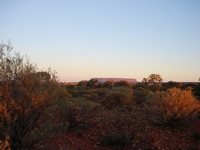
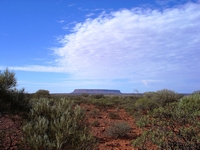
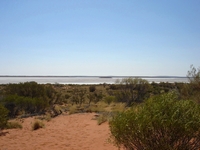
Many tourists come to see Uluru on tour coaches and most are taken on one short walk only, seeing so little of the Rock they have
come so far to see. There is a loop road around Uluru with several parking areas, including one suitable for sunrise viewing. The sunset viewing area is along the access road in to Uluru.
A walk also circumnavigates the rock, in some places close and in others taking a wide arc away from the perimeter due to cultural
sensitivity of the area. Aboriginal rock paintings can be seen in several locations.
This salt pan can be seen from near the parking area for viewing Mount Conner. Walking across the busy road we climbed through
loose red sand for a better view of the
Mount Conner (Atila) is a large
Mount Conner usually appears pink or lilac in the distance which contrasts to the orange tones of Uluru. The mesa is on
Curtin Springs Station and can only be accessed by tours run from the station. We drove a little way down the
People coming down were sliding or ‘crab walking’ on their bottoms. At this point, even before the steep and slippery access
to the chain, a group of Japanese girls were slipping over as they tried to take a step, and laughing joyously.
We walked around the rock in a clockwise direction, the first section including the Mala walk to a rock painting gallery. Most
of the tour coach passengers were only taken this far and we met only a few other people on the rest of the walk.
The first part of the climb is made safer by a chain, but there is a short distance from where the climbing is easy to the start of the chain. The Ulu?u climb closed permanently from 26 October 2019 and the chain was removed.
When we arrived at Yulara, the town built to service tourism to Uluru, the wind was fierce and it was very dusty. As the weather
worsened, we decided that it was not a good day to go sight seeing. Yulara was built between 1982 and 1984 and by the end of
1984 all accommodation at “The Rock” in the national park was removed.
There are viewing areas within the Ayres Rock campground at Yulara. Shadows of the fast moving clouds danced across the
rock, giving it a lilac hue.
Next morning in fine weather we drove eighty kilometres to the Rock. Entrance to the Uluru –
Like a giant mouth, cracks and erosion have created features such as this on, seen on the southern side.
The north side has patches of honeycomb erosion.
Caves and waves along the Mala walk.
Natural wood chairs are placed at intervals around the walk.
The path up the rock can be seen following the ridge in the centre of the picture below.
The path up the rock can be seen following the ridge in the centre of the picture below. The Ulu?u climb closed permanently
from 26 October 2019.
The walk is closed if the day is too hot, the wind to strong, rain is forecast, cloud covers top of the rock and it is closed from
sunset to sunrise. It is closed after 8 am during December, January and February and on any day forecast to reach 36°C. These are for the safety of climbers. It is also closed at times of cultural significance or if a rescue is taking place. The Ulu?u climb closed permanently from 26 October 2019 and the chain was removed.
Aboriginal rock paintings found underneath one of the overhangs.
Having completed the 9.4 kilometre loop walk, we returned to the car park near the start of the climb. With the day warming
up, there was no longer the ant trail of climbers along the chain with only a few climbers heading up or down.
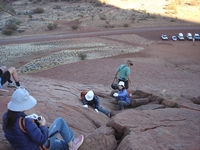
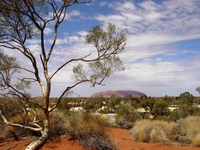
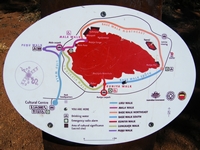
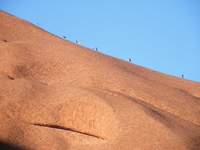
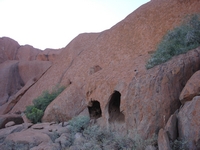
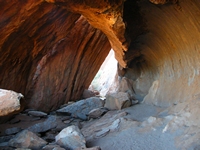
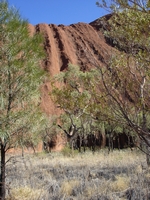
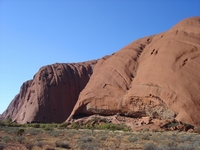
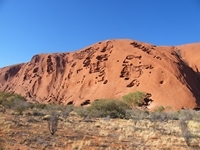
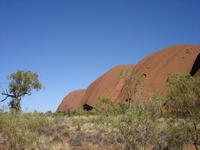
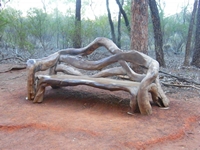
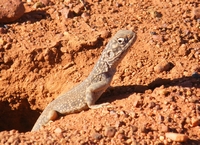
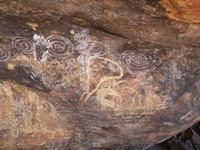
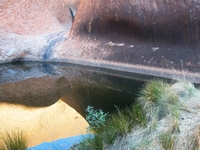
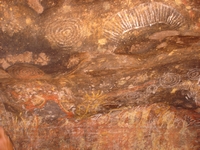
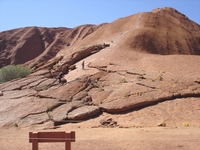
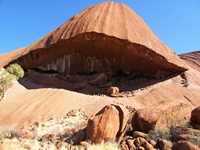
Clouds were moving quickly in a windy sky over Mount Conner by morning.
We watched the sun set on Mount Conner. Explorer William Gosse named the mount in 1873 after M.L. Conner, a South Australian
politician. Both spellings of Conner and Connor can be seen on brochures and maps.
Almost 100 kilometres west of Mount Conner is Uluru. Named Ayres Rock in 1873 by William Gosse after the Premier of South Australia
Sir Henry Ayres, ‘The Rock’ is one place the tourists flock to see. The National Park Park now known as Uluru-Kata Tjuta was
created in 1958.
footage, recording or likeness of Ulu?u-Kata Tju?a National Park, whether new or existing, true to life or a representation. This also applies to using or capturing images, footage, recording or likeness of Ulu?u-Kata Tju?a
National Park from outside the park boundaries. Images, footage, recordings, artwork or any other likeness will be captured by the wording ‘image/s and/or footage’ in this document.